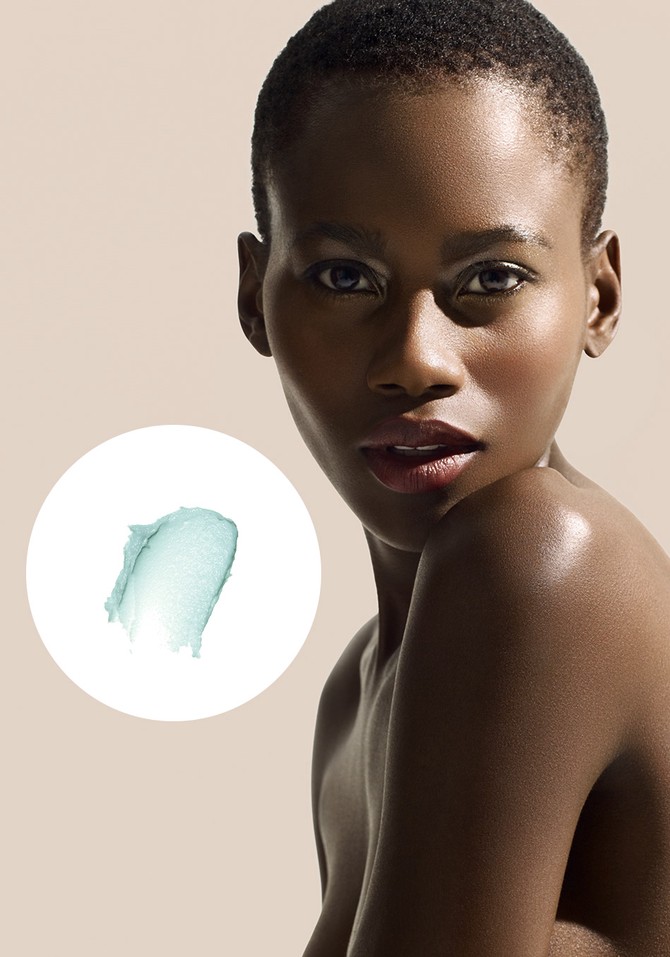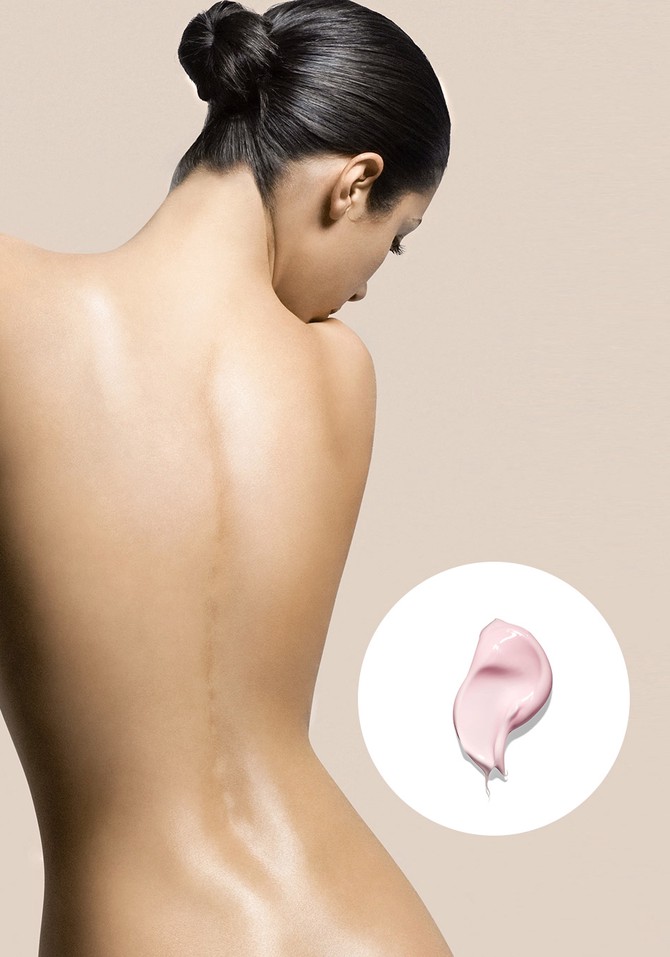The 2-Step Plan for Glowing Skin
From secrets for velvety skin to the smartest advice for shaving and waxing, we've got the info you need to get your body into optimum condition.

Model: Trunk Archive, Product: Chris Eckert/Studio D
Step 1: Exfoliate
Getting supremely supple skin isn't just a matter of slapping on a coat of lotion and calling it a day. First you have to deal with the dead cells that have built up on the skin's surface. Eliminating this debris allows light to reflect evenly off the skin, giving you more glow. It also helps your moisturizer penetrate more deeply, increasing its effectiveness. When it comes to exfoliation, take your pick between two options: physical (like a scrub) and chemical (such as an acid-based lotion).
Let's Get Physical
For an immediate improvement, try a mechanical exfoliant, which works by literally buffing off the layer of dead skin, says Washington, D.C., dermatologist Tina Alster, MD. The options? A loofah, a body polish, or a sugar or salt scrub. You will be unsurprised to learn that in general, softer scrubbing particles are gentler on your skin. Of course, if the scrubber is too soft (think jojoba beads), it's not worth the trouble. So where's the sweet spot? "I think sugar grains are the ideal," says Miami dermatologist Leslie Baumann, MD. Just don't overdo any physical exfoliant: You risk going from dull to irritated.
Chemical Attraction
Chemical exfoliants loosen the bonds that hold skin cells together, says Alster. "As we age, the cells get stickier and the mortar is denser, so cellular buildup is more likely to occur." The best ingredients to tackle the job, according to Baumann, are alpha hydroxy acids, such as glycolic acid, and beta hydroxy acids, like salicylic acid, which is also good for breakouts because it cleans your pores and reduces acne-related inflammation. You can find acids in all kinds of products, but Baumann suggests a lotion or a cream because they are easy to apply and remain on your skin instead of getting rinsed off. When used once or twice a week, chemical exfoliants will produce results in about two weeks to a month, Alster says.
Let's Get Physical
For an immediate improvement, try a mechanical exfoliant, which works by literally buffing off the layer of dead skin, says Washington, D.C., dermatologist Tina Alster, MD. The options? A loofah, a body polish, or a sugar or salt scrub. You will be unsurprised to learn that in general, softer scrubbing particles are gentler on your skin. Of course, if the scrubber is too soft (think jojoba beads), it's not worth the trouble. So where's the sweet spot? "I think sugar grains are the ideal," says Miami dermatologist Leslie Baumann, MD. Just don't overdo any physical exfoliant: You risk going from dull to irritated.
Chemical Attraction
Chemical exfoliants loosen the bonds that hold skin cells together, says Alster. "As we age, the cells get stickier and the mortar is denser, so cellular buildup is more likely to occur." The best ingredients to tackle the job, according to Baumann, are alpha hydroxy acids, such as glycolic acid, and beta hydroxy acids, like salicylic acid, which is also good for breakouts because it cleans your pores and reduces acne-related inflammation. You can find acids in all kinds of products, but Baumann suggests a lotion or a cream because they are easy to apply and remain on your skin instead of getting rinsed off. When used once or twice a week, chemical exfoliants will produce results in about two weeks to a month, Alster says.

Model: Trunk Archive, Product: Chris Eckert/Studio D.
Step 2: Moisturize
Now comes the hydration. If you want ultrasoft skin (and who doesn't?), look for two kinds of ingredients, advises Naana Boakye, MD, a dermatologist in Englewood Cliffs, New Jersey. "Occlusive moisturizers, such as jojoba oil or petrolatum, work by forming a barrier that blocks water from escaping the skin," Boakye says. "Humectants like glycerin, urea, and hyaluronic acid attract water to skin." To harness maximum benefits, choose a product containing both types. Keep in mind that generally, the thicker the moisturizer, the stronger it is: A butter is more hydrating than a lotion, which is more powerful than a milk. One effective trick for extra-dry skin is to apply a layer of oil to damp skin first and then seal it with a coat of cream.
Tough Problem
Skin on elbows, knees, and heels tends to be thicker than the skin on the rest of the body; it's also drier. To eradicate rough, flaky patches, Boakye suggests a lotion or cream containing lactic acid or urea, which are exfoliants as well as humectants, to improve texture and hydrate. Apply daily and you should see improvement in three to four weeks, she says.
Red or white bumps on your upper arms and thighs may be due to keratosis pilaris, the buildup of dead cells around hair follicles. Boakye often prescribes a regimen of a 15 percent glycolic acid lotion daily, along with a scrub two or three times a week. "It usually takes up to three weeks to see significant improvement," she says.
For the skin on your neck and chest, you can use the same treatment products you use on your face, with a caveat: This skin is thinner and has fewer oil glands, so it's more sensitive to active ingredients, says Brooke Jackson, MD, a dermatologist in Chapel Hill, North Carolina. Dilute facial treatments, like vitamin C serums and retinoids, by blending them with a pea-size drop of moisturizer. And remember to prevent further damage by applying an SPF 30 daily, says New York City dermatologist Ellen Marmur, MD.
Tough Problem
Skin on elbows, knees, and heels tends to be thicker than the skin on the rest of the body; it's also drier. To eradicate rough, flaky patches, Boakye suggests a lotion or cream containing lactic acid or urea, which are exfoliants as well as humectants, to improve texture and hydrate. Apply daily and you should see improvement in three to four weeks, she says.
Red or white bumps on your upper arms and thighs may be due to keratosis pilaris, the buildup of dead cells around hair follicles. Boakye often prescribes a regimen of a 15 percent glycolic acid lotion daily, along with a scrub two or three times a week. "It usually takes up to three weeks to see significant improvement," she says.
For the skin on your neck and chest, you can use the same treatment products you use on your face, with a caveat: This skin is thinner and has fewer oil glands, so it's more sensitive to active ingredients, says Brooke Jackson, MD, a dermatologist in Chapel Hill, North Carolina. Dilute facial treatments, like vitamin C serums and retinoids, by blending them with a pea-size drop of moisturizer. And remember to prevent further damage by applying an SPF 30 daily, says New York City dermatologist Ellen Marmur, MD.
From the April 2015 issue of O, The Oprah Magazine

